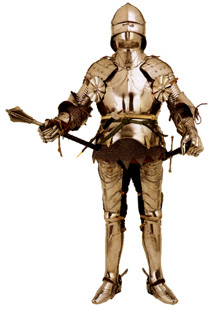DK History: Medieval Europe
Between AD 1000 and 1500, a lively society developed in Europe. Although most people still worked on the land, this was also the age of CASTLES, cathedrals, and growing towns. Gradually, the traders and craftsmen of the towns began to have more influence on government.
Kings led armies of KNIGHTS and foot soldiers. They made laws, collected taxes, and encouraged trade. Nobles ran great estates, given to them on the condition that they would help the king rule. The Church was important in every area of life, providing medieval Europe with its schools, hospitals, and universities.
Medieval Europeans believed that God had made the world, and ruled it through his Church and the king. Few people, apart from priests and monks, could read and write. Ordinary people learned the stories of the Bible and the saints from preachers, and from the pictures painted in their churches.
Many towns grew up around markets, where farm produce was exchanged for the goods and services of specialized craftsmen, such as shoemakers and weavers. Through their guilds, traders and craftsmen regulated prices and organized the training of their apprentices.
Most peasants worked on their local lord’s fields in return for their own plots of land. Some, called serfs, were not free, and could not travel, or marry, without their lord’s permission. Skilled men could be thatchers or carpenters. Women might weave cloth or brew ale.
Eleanor of Aquitaine was the richest heiress in France. She married King Louis VII of France in 1137, but by 1154, she was married to King Henry II of England. In her old age she remained a powerful woman, ruling England during the absence of her son, King Richard.
A castle is a huge, fortified building, or set of buildings. The first castles, built around 900, were made up of a wooden fortress on top of an earth mound. Later, castles built of stone had towers, battlements, moats, and strong defensive walls. They also became prestigious homes.
The first castles were built to shelter nobles, KNIGHTS, and soldiers in a war. After around 1200, in times of peace, each castle had its own nobleman and his family living in it. Comfortable private rooms were added for important guests.
From around 1300, gunpowder for firing cannons began to affect warfare in Europe. Cannon balls could smash through stone walls, making castles less useful as safe strongholds. Castles continued to be built, but for show. They were intended as impressive residences rather than indestructible fortresses.
Knights were warriors on horseback. They came from noble families and were trained from boyhood to handle weapons, wear armor, and ride heavy war horses. Some knights owned castles and land, and kept local order. Others served in the private armies of great lords. Each knight had his own coat of arms, helping him to tell friend from foe in battle.
Knights charged into battle on horseback, spearing enemy soldiers with their long lances, or slashing at them with heavy swords, maces, and battle-axes. On foot, they fought with daggers and short swords.


